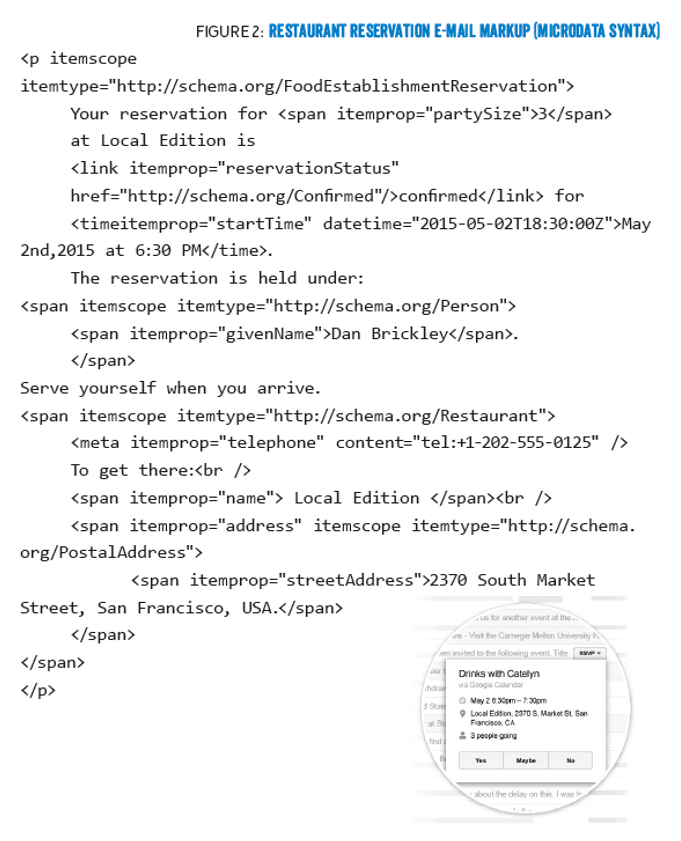-
 11 min. read
11 min. read
-
 Trevin Shirey
Trevin Shirey VP of Marketing
VP of Marketing
- Trevin serves as the VP of Marketing at WebFX. He has worked on over 450 marketing campaigns and has been building websites for over 25 years. His work has been featured by Search Engine Land, USA Today, Fast Company and Inc. Read his review of working with WebFX for the last 15 years.
Schema markup (also called schema or structured data) is one of the skillsets you need when implementing technical SEO onto your site.
It allows search engines like Google to better crawl and, more importantly, understand the information on your site to provide better results for users.
Schema markup is also one of the best ways you can use to stand out from your competitors in search results. It’s a good thing to take advantage of since only 30% of pages online use Schema.org to markup their pages. That’s why you want to use structured data for SEO.
So, what is schema markup in SEO, and how can you implement schema markup for Google?
Keep reading to learn more and subscribe to Revenue Weekly to stay up to date with the latest SEO trends and tips!
What is schema markup?
Schema markup is coding that allows you to create enhanced descriptions that appear in search results.
Using schema.org to markup your site allows you to optimize your website so search engines can read your site and provide more informative results for searchers.
Due to its standardized semantic vocabulary, schema markup added to your site’s HTML helps the major search engines understand your page’s information better and return richer, more informative results like this one for users:
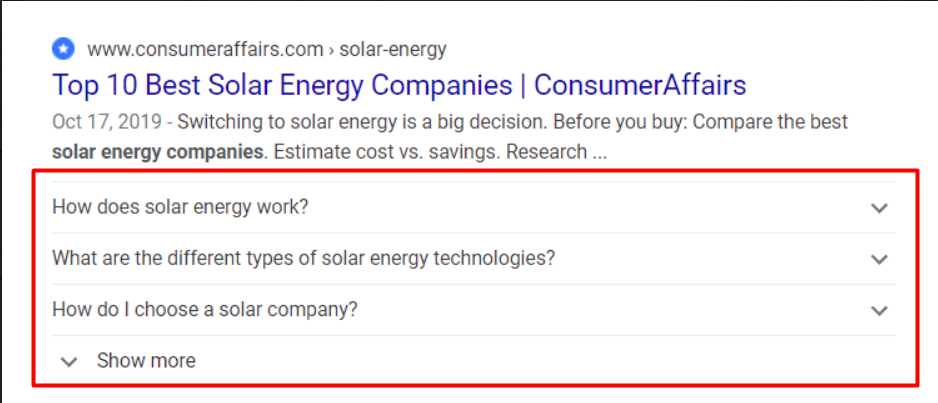
Schema.org identifies over 10 million sites who use the vocabulary to markup their web pages and email messages. The goal of search engines like Google is to provide users with valuable, relevant information. To do that, search engines need to know what’s on your page.
They can do that by looking at your headings, keywords, and other text, but some problems come doing it this way.
While machine learning is improving the process, context reading algorithms can still get caught up in the semantics of words.
Search engines might have trouble understanding the difference between “apple,” the fruit, or “Apple,” the product.
With structured data, search engines know without a doubt that a web page is talking about the company “Apple” and not the fruit without having to rely on guesswork from the content on the page.
Various types of schema markup, such as local business schema, helps search engines understand the context of those words. Search engines can use the class and value to categorize and index your page. Here are some examples of classes and the values that go with them:
| Class | Example of Value |
|---|---|
| Type | Local business |
| Name | Sunergy Systems |
| URL | https://sunergysystems.com/ |
| Address | 4546 Leary Way NW, Seattle, WA 98107 |
| Phone | (206) 297-0086 |
| Reviews | 4.6 out of 5 |
Structured data not only helps search engines crawl and index information, but it also helps the algorithms understand what they are reading.
The difference between schema markup and structured data
Schema markup is often used as a synonym for structured data, but there is a slight difference between the two:
- Structured data is any code within your HTML that provides explicit hints that lets search engines understand and classify page content, as well as information about the publisher’s entity.
- Schema markup is structured data that has a standardized set of defined values and classes.
Schema markup, as a standardized structured data vocabulary, is the result of Schema.org, a joint effort between Google, Bing, Yahoo, and Yandex.
Schema markup combats the structured data problem where webmasters, search engines, and other online platforms each use their own unique vocabulary (or sometimes several), along with a wide range of (often duplicate) classes, to implement structured data into code.
The standardized tags of schema markup make marking up structured data much easier, with much less room for error due to incorrect formatting.
Encoding schema markup: What is Microdata, RDFa, and JSON-LD?
Currently, schema markup vocabulary can be used with several different encoding syntaxes, including Microdata, RDFa, and JSON-LD. Google currently supports the three previously mentioned structured data formats. Here are the major differences:
- RDFa (Resource Description Framework in Attributes): RDFa was one of the earlier structured data notations that could be added throughout your HTML code, and though originally, it was quite complex, there have been revisions over the years that have made it less complex for publishers to implement.
- Microdata: Microdata encoding was originally promoted by Schema.org over RDFa because of RDFa’s complexity. Microdata has many elements similar to RDFa. Its notation system can be used throughout your HTML code much like RDFa, but in most cases, it’s mainly used within your HTML code’s <body> tag.
- JSON-LD (JavaScript Object Notation for Linked Data): JSON-LD is perhaps the structured encoding system that’s most used by site developers. It’s a little bit easier to use since all the schema vocabulary used for JSON-LD can be placed within your HTML code’s <script> tag rather than scattered throughout your HTML. This helps with organization and accuracy and is a big reason why both Schema.org and Google are currently endorsing it.
Another benefit is that Google can read any JSON-LD you happen to have embedded within your page’s JavaScript elements or widgets.
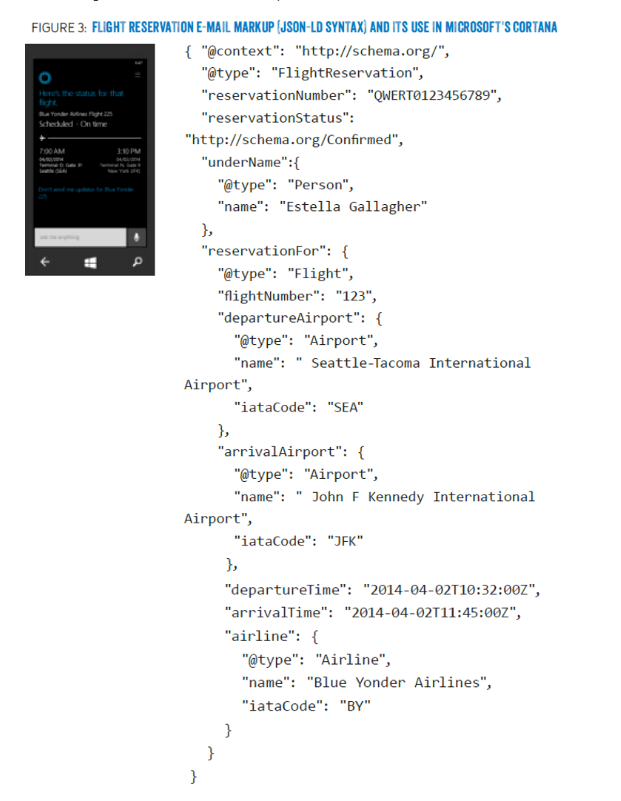 Image Source Web publishers have their own reasons for using one format over another, but considering that JSON is recommended by both Schema.org and Google, many web publishers opt for it because of it’s simpler organization structure under the <script> tag.
Image Source Web publishers have their own reasons for using one format over another, but considering that JSON is recommended by both Schema.org and Google, many web publishers opt for it because of it’s simpler organization structure under the <script> tag.
Why is schema markup important to SEO?
Schema markup is important because it:
- Improves search engines’ ability to crawl your site: With schema, you’ll be telling search engines exactly what’s on your page. This process helps especially with local businesses by helping clarify information about their business, such as what they sell and how to contact them.
- Increases your site’s visibility on search pages: Schema markup adds more information to your organic results, making it more visible, attractive, and engaging to users. Schema boosts your SEO because users are more likely to click on your result than one without schema markup. With more clicks, you’ll rank higher in search results.
- Boosts your visitor’s user experience: The extra information allows users to make more informed decisions, so you’ll be getting more qualified traffic and boosting conversions.
Google uses the schema markup on your page to create rich snippets in search results, which provide users with information such as reviews or product information that make them more likely to click to your site.
An organic result without rich snippets:

An organic result with rich snippets:

Google also uses schema markup as a data source for Knowledge Graphs, which provide background information about well-known entities such as a brand.
While schema markup doesn’t directly affect your rank, Google shows organic results with schema markup more prominently on search results.
They often take up more room on search pages than organic results without markup. A more prominent result like this will be more visible to users, increasing your site’s click-through rate.

How to implement schema markup to boost your SEO
If you’re thinking about adding schema markup to one of your site’s pages, Google provides a couple of tools to help you do that without needing to wade knee-deep into Schema.org.
Adding schema markup doesn’t guarantee that your listing will show in search results, but it will ensure that Google has the information it needs when determining if your page is relevant to searchers. Also, keep in mind that any schema markup you add to your page needs to be relevant to your whole page, not just a part.
If you use WordPress for your site, you can use the free Yoast SEO plugin to help you add schema markup to your site.
Looking for an all-in-one SEO audit tool? You’ve found it
SEO checker provides data on key metrics to give you:
- Complete SEO score
- Site Speed Analysis
- Content Grade
- and more.
Otherwise, you can follow these three steps:
1. Find the page you want to add schema markup to
Start by identifying the page that would benefit the best from schema markup. Google provides a search gallery of common page types that work well with schema markup, so if you don’t know where to start, you can start there.
Product pages and pages containing your contact information often benefit the most from schema markup, since Google displays those prominently on search results.
2. Test your site
Once you have the page you want to work with, you’ll want to test your site using a structured data testing tool like the one offered by Google. There are a couple of reasons to do this:
- It helps you identify the schema markup you already have on the page (if any)
- It suggests schema markup that would be useful for your page
- It points out errors in your schema markup
Testing your page gives you an idea of what kind of markup would be beneficial to add, especially if you don’t know where to start. You’ll also need to test your site again as a final step to adding schema markup to your page, so don’t forget.
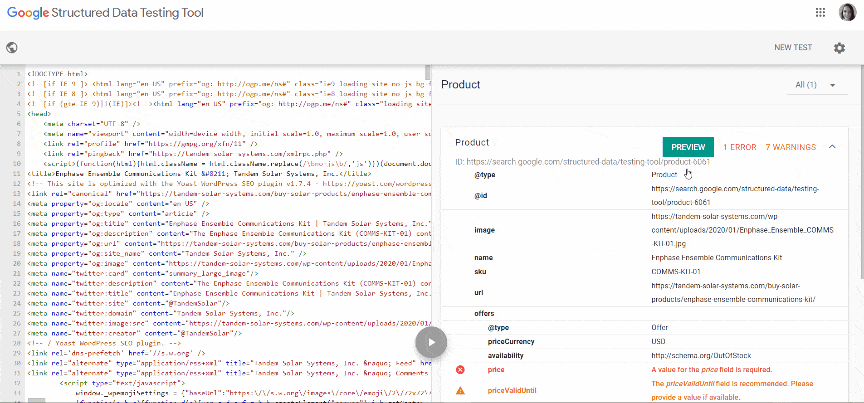
3. Generate your schema markup
Google’s Structured Data Markup Helper is a useful tool that will help code your schema markup for you. With it, you can choose to add schema to a website or email.
We’ll show you how to do so with a website. You’ll first want either your page’s URL or HTML code.
You’ll also want to identify what type of content is on the page. Once you have that, select “Start Tagging.”
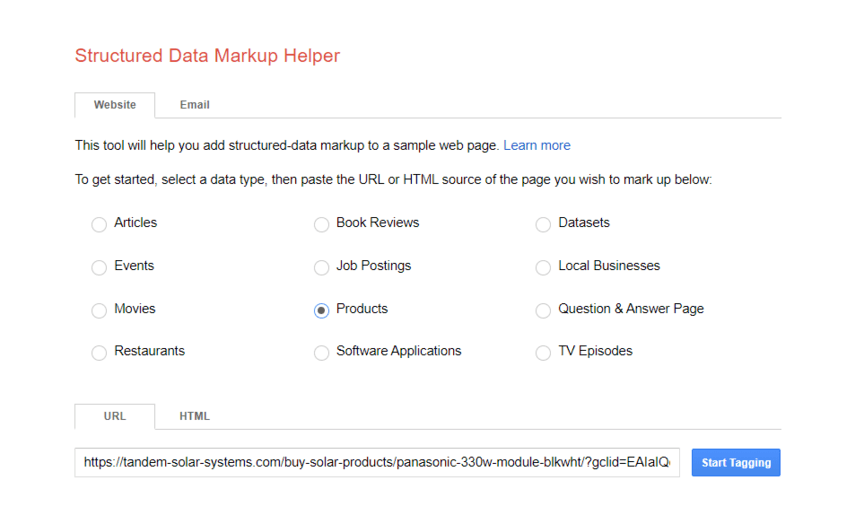
The helper will bring you to a page that lets you start adding schema tags to your content.
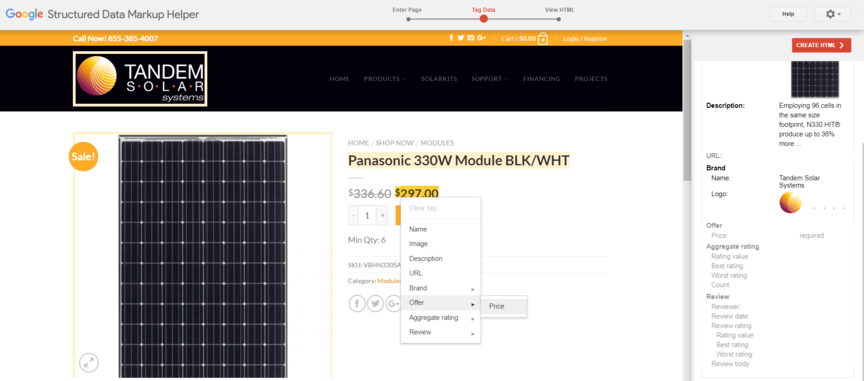
Once on this page, you start tagging simply by highlighting items on the page. A highlighted item, such as this solar panel’s price from the example, will bring up a drop-down menu where you can select the data type that best fits the highlighted item.
(In our example, that would be Offer > Price.)
You can also manually add tags for any data you can’t select. After you’ve selected tags for all the relevant data on your page, select “Create HTML” in the top right, which will bring you to a page where you can select your schema syntax.
Here’s an example of using Microdata for schema markup:
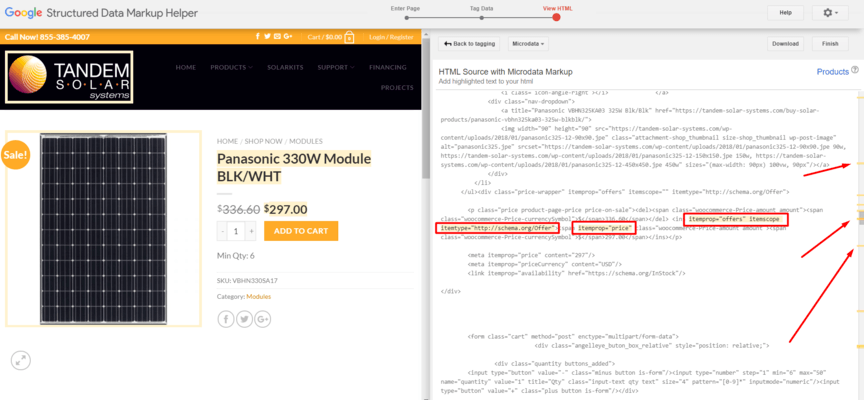
Google automatically highlights the portions of schema markup that is added to your HTML.
You can find them using the marks on your scroll bar. You can either copy and paste the Microdata snippets into your HTML body, or you can download the code here as an HTML file.
On the other hand, here’s what JSON-LD would look like:
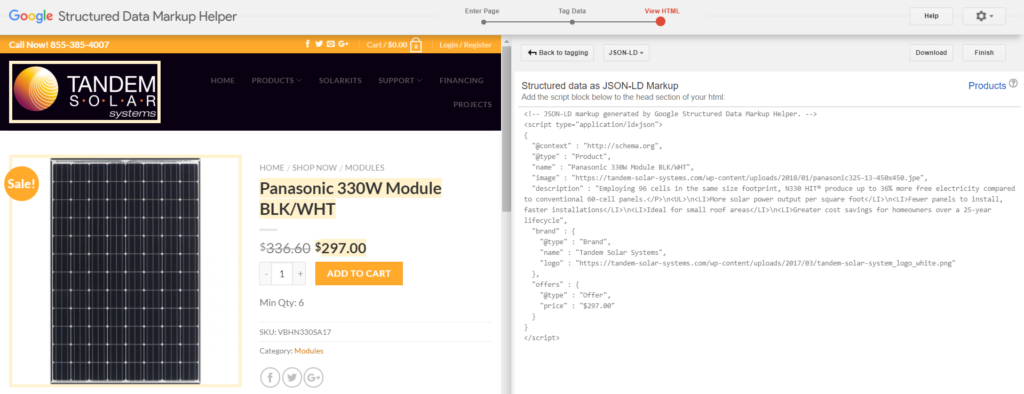
JSON is easier to incorporate into your code because the schema markup is grouped together, unlike with Microdata.
You can just copy and paste this into the head section of your HTML.
Need help? Let WebFX help you with your schema markup!
Schema markup can be tricky. There are many different types and properties, and you need to identify and encode which ones best fit the information on your page.
You also need to take the time to analyze your schema performance and evaluate how well it’s working.
That’s a lot of information to sift through. Save yourself the time and energy while still getting all the schema markup benefits by working with the top SEO company in the world!
Our SEO services will make sure you are driving the results you want. Contact us online or call us at 888-601-5359 to learn more!
-
 Trevin serves as the VP of Marketing at WebFX. He has worked on over 450 marketing campaigns and has been building websites for over 25 years. His work has been featured by Search Engine Land, USA Today, Fast Company and Inc. Read his review of working with WebFX for the last 15 years.
Trevin serves as the VP of Marketing at WebFX. He has worked on over 450 marketing campaigns and has been building websites for over 25 years. His work has been featured by Search Engine Land, USA Today, Fast Company and Inc. Read his review of working with WebFX for the last 15 years. -

WebFX is a full-service marketing agency with 1,100+ client reviews and a 4.9-star rating on Clutch! Find out how our expert team and revenue-accelerating tech can drive results for you! Learn more
Try our free Marketing Calculator
Craft a tailored online marketing strategy! Utilize our free Internet marketing calculator for a custom plan based on your location, reach, timeframe, and budget.
Plan Your Marketing Budget
Table of Contents
- What is schema markup?
- The difference between schema markup and structured data
- Encoding schema markup: What is Microdata, RDFa, and JSON-LD?
- Why is schema markup important to SEO?
- How to implement schema markup to boost your SEO
- 1. Find the page you want to add schema markup to
- 2. Test your site
- 3. Generate your schema markup
- Need help? Let WebFX help you with your schema markup!

SEO Success with KOA

Proven Marketing Strategies
Try our free Marketing Calculator
Craft a tailored online marketing strategy! Utilize our free Internet marketing calculator for a custom plan based on your location, reach, timeframe, and budget.
Plan Your Marketing Budget
What to read next






